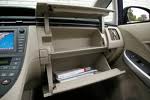If you are like me, you probably have napkins and straws from fast food restaurants and other assorted items in your glove box in the car. It can be a nifty storage place, but it’s main purpose is to keep some important documents related to the car. 
It is very important that you keep all of the necessary documents in the car glove box. These items will be necessaryif you are stopped by a police officer or have an auto accident. Not having these items can result in your receiving a ticket (citation) from a police officer.
Essential Documents
- Car Registration Card*
- Insurance Card*
- Car Accident Emergency Form
- Pages 5 & 6 from MD Driver’s Handbook (Highlight the part that says the ”Persons Exempt from Licensing” and continuing onto page 6 “Any nonresident of this state provided that…”)
*Some host parents may tell you to carry these in your wallet instead of keeping them in the car. Follow their instructions.
Helpful Extras
- Flashlight
- Tire Pressure Gauge
- Vehicle Owner’s Manual
- Map or GPS
- Tissues and Hand Sanitizer
- First Aid Kit
In Your Wallet
Carry your Maryland license or country driver’s license and international driver’s permit with you at all times, especially when you are driving. You should leave your passport and Social Security Card and other documents at home, to reduce the risk of losing them





